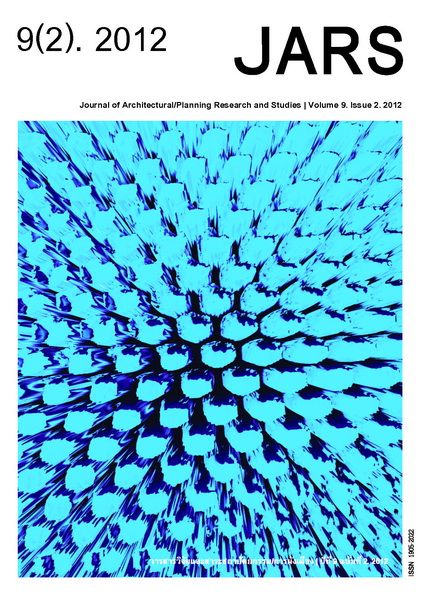Benefits of Roof-Mounted Solar Cells for Low-Cost Residential Buildings
Main Article Content
Abstract
This research article presents part of a study on using roof-mounted solar cells as alternative energy for water treatment systems of low-cost residential buildings of National Housing Authority of Thailand (NHA). The benefits of roof-mounted solar cells on buildings are beyond their obvious capability of electricity production. Other benefits include heat transfer reduction from the building envelope, carbon emission reduction, backup electricity for use during disaster and economical feasibility study. The study explored the tangible and intangible benefits of solar arrays with capability of 2.22 kW (0.185 kW/array) which can produce the 2.10 kWh/day of the electricity required by water treatment systems (up to 5.48 kWh/day). The benefits on a building envelope’s heat transfer is that by using solar arrays to cover about 81% of the roof area, the indoor temperature of the room adjacent to the roof can be reduced by up to 4๐C. For carbon emission reduction, by using solar cells for the energy in water treatment systems, it is possible to achieve a reduction of 44.91-718.61 Ton CO 2 , depending on the system management of 15 minutes, 3 hrs and 24 hrs shut-off integral. The carbon emission reduction is equivalent to between 6 and 107 cars on the street. By designing the solar cells to support water treatment systems for 24 hrs, the energy produced can cover public electricity use during a disaster. Up to 33.60 kWh/day can be produced: this is about 1.4 times more than the electricity typically required in normal circumstances. The economical feasibility study of the project includes a comparison of using roof-mounted solar cells and a solar farm. For this particular project, at low-cost residential buildings in Bung-Kum, the economical feasibility (payback period) is 5.82 times than building a solar farm on the same land alone.
Downloads
Article Details

This work is licensed under a Creative Commons Attribution-NonCommercial-NoDerivatives 4.0 International License.
All material is licensed under the terms of the Creative Commons Attribution 4.0 International (CC-BY-NC-ND 4.0) License, unless otherwise stated. As such, authors are free to share, copy, and redistribute the material in any medium or format. The authors must give appropriate credit, provide a link to the license, and indicate if changes were made. The authors may do so in any reasonable manner, but not in any way that suggests the licensor endorses you or your use. The authors may not use the material for commercial purposes. If the authors remix, transform, or build upon the material, they may not distribute the modified material, unless permission is obtained from JARS. Final, accepted versions of the paper may be posted on third party repositories, provided appropriate acknowledgement to the original source is clearly noted.
References
Chenvidyakarn, T. (2010). PasCal (v.1.0) [Computer software]. Retrieved December 20, 2010, from http://www.arct.cam.ac.uk/ArctShared/Document.aspx?p=23&ix=4561&pid=99&prcid=8&ppid=1294.
DeGunther, R. (2010). Solar power your home for dummies (2nd ed.). Indianapolis, IN: Wiley Publishing.
Department of Alternative Energy Development and Efficiency & Faculty of Science, Silpakorn University. (1999). แผนที่พลังงานแสงอาทิตย์ [Solar energy map]. Retrieved January 2, 2012, from http://www2.dede.go.th/renew/sola/mapmenu.html.
Department of Alternative Energy Development and Efficiency [DEDE]. (2005). แนวทางการลงทุนจัดตั้งอุตสาหกรรมการผลิตเซลล์แสงอาทิตย์ในประเทศไทย [Investment guideline for solar cell manufacturing industry in Thailand]. Retrieved April 1, 2012, from http://www.thaisolarfuture.com/upload/files/2(1).pdf.
Department of Alternative Energy Development and Efficiency [DEDE]. (2008). แผนพัฒนาพลังงานทดแทน 15 ปี (พ.ศ. 2551-2565) [Renewable energy development plan: REDP]. Retrieved September 6, 2011, from http://www.dede.go.th/dede/images/stories/y51_y65.pdf.
Department of Alternative Energy Development and Efficiency [DEDE]. (2010). รายงานสถิติพลังงานของประเทศไทย (เบื้องต้น) 2553 [Thailand energy statistics 2010 (preliminary)]. Retrieved October 10, 2010, from http://www.dede.go.th/dede/images/stories/stat_dede/Th_En_St_2010_p.pdf.
Department of Alternative Energy Development and Efficiency [DEDE]. (2011). Thailand PV status report 2011. Retrieved February 9, 2012, from http://www.dede.go.th/dede/images/stories/pdf/t_pv_11.pdf.
Dominguez, A., Kleissl J. & Luvall, J.C. (2011). Effects of solar photovoltaic panels on roof heat transfer. Solar Energy, 85(9), 2244-2255. Retrieved February 10, 2012, from http://www.sciencedirect.com/science/article/pii/S0038092X11002131.
Department of Alternative Energy Development and Efficiency [DEDE]. (2012). ความเข้มแสง และศักยภาพเชิงพลังงานแสงอาทิตย์ทั่วประเทศ [Solar radiation intensity and solar energy efficiency potential in Thailand]. Retrieved January 2, 2012, from http://www.dede.go.th/dede/index.php?option=com_content&view=article&id=1512:2011-01-10-05-52-10&catid=52&Itemid=68&lang=en.
Electricity Generating Authority of Thailand. (2012). ปริมาณการปล่อยก๊าซคาร์บอนไดออกไซด์ (CO2) จากโรงไฟฟ้าของ กฟผ. ปี 2554 [Quantity of carbon dioxide emission (CO2) from EGAT power station]. Retrieved April 1, 2012, from http://www.egat.co.th/wwwthai/images/stories/social/2011egat-co22554.pdf.
Energy Policy and Planning Office[EPPO]. (2010). รายงานสถิติพลังงานของประเทศไทย 2553 [Energy statistics of Thailand 2010]. Retrieved August 25, 2010, from http://www.eppo.go.th/info/YearBook/EnergyStatisticsofTHAILAND2010.pdf.
Energy Policy and Planning Office[EPPO]. (2012). รายงานสถิติพลังงานของประเทศไทย 2554 [Energy statistics of Thailand 2012]. Retrieved March 31, 2012, from http://www.eppo.go.th/info/cd-2011/pdf/Book%20all_new.
pdf.
European Photovoltaic Industry Association. (2011). Solar generation 6: Solar photovoltaic electricity empowering the world. Retrieved February 23, 2012, from http://www.epia.org/index.php?id=18.
Intergovernmental Panel on Climate Change. (2011). Renewable energy sources and climate change mitigation. Retrieved December 30, 2011, from http://srren.ipcc-wg3.de/report/IPCC_SRREN_Full_Report.pdf
Kruangam, D. (2011). การอบรมให้ความรู้เกี่ยวกับโรงไฟฟ้าพลังงานแสงอาทิตย์ [Training on solar energy power station]. Bangkok, Thailand: Thai Solar Future.
Kolhe, M., Kolhe, S., & Joshi, J.C. (2002). Economic viability of stand-alone solar photovoltaic system in comparison with diesel-powered system for India. Retrieved February 20, 2012, from http://www.stanford.edu/group/solarbenin/references/Kolhe-2002-Solar-v-Diesel.pdf.
Luque, A., & Hegedus, S. (2011). Handbook of photovoltaic science and engineering (2nd ed.). West Sussex, England: John Wiley & Sons.
National Housing Authority. (2010). โครงการวิจัย ทดลองปฏิบัติการ โดยนำจุลินทรีย์ที่มีประสิทธิภาพ (EM) มาใช้ในการลดค่าใช้จ่ายการบำบัดน้ำเสีย โครงการเคหะชุมชมและโครงการบ้านเอื้ออาทร [A pilot plant research project using effective microorganism (EM) for cost saving in wastewater treatment in community and Eua-arthorn housing projects]. Bangkok, Thailand: Author.
OY Not LLC. (2009). World solar insolation map. Retrieved January 2, 2012, from http://www.oynot.com/solarinsolation-map.html.
The Treasury Department. (2012). สรุปราคาประเมินทุนทรัพย์ที่ดิน รอบบัญชี ปี พ.ศ. 2555-2558 [A summary of real estate appraisal report (accounting period 2012-2015)]. Retrieved April 31, 2012, from http://www.treasury.go.th/internet/land/bangkok/buengkoom_New.pdf.
Young, W. (2003). Renewable energy and disaster-resistant buildings. Retrieved April 3, 2011, from http://www4.eere.energy.gov/solar/sunshot/resource_center/sites/default/files/m-fsec-pf-385-05.pdf.


